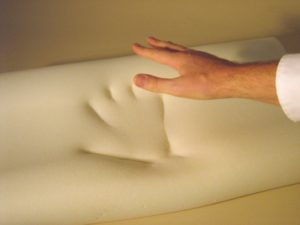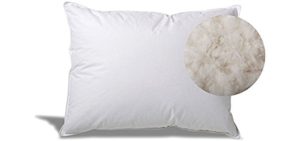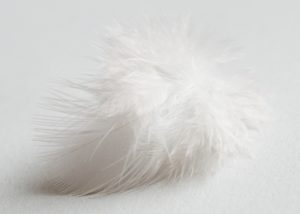The pillow you use helps determine your back and neck alignment. A good pillow means that you’ll experience a deeper, more restful sleep and wake up less during the night. But a bad pillow does a lot more than make it difficult to sleep. Besides tossing and turning, an uncomfortable pillow can exasperate shoulder and arm pain while worsening migraines and headaches, all by causing neck pain. If you find yourself experiencing these symptoms or a stiff, sore feeling in your neck and spine, odds are good that you’re using a pillow that’s not a good fit for you personally.
How do you find a pillow that’s good for treating neck pain? While there’s no single pillow on the market that will work for everybody, two main factors need to be considered: the cervical curvature of your neck and the position you assume when you sleep. Overall you want your pillow to keep your head aligned with your shoulders while also supporting the structure of the neck. To this end, you’ll want to closely consider the shape, dimensions, and materials of any prospective pillow you buy.
Look at How You Sleep
 What you need to keep your neck and spine in alignment will depend on how you position yourself when you sleep. The three most common positions are on your back, on your side (including the fetal position) and on your stomach. There’s no “correct” way to sleep when comparing the three, and for most of us, we simply choose what feels the most natural without giving it much thought. But each position applies pressure and stress along your spine differently, and your head’s placement relative your neck and shoulders will vary wildly.
What you need to keep your neck and spine in alignment will depend on how you position yourself when you sleep. The three most common positions are on your back, on your side (including the fetal position) and on your stomach. There’s no “correct” way to sleep when comparing the three, and for most of us, we simply choose what feels the most natural without giving it much thought. But each position applies pressure and stress along your spine differently, and your head’s placement relative your neck and shoulders will vary wildly.
It may seem like back sleepers have an easier time of things, for instance, because when lying flat on your back on a mattress, your head and shoulders are in a relatively straight line. But this doesn’t account for the curve of the neck. Without proper support, this area can become strained during the night and lead to tossing and turning. Back sleepers will get the most out of a thin pillow. A thicker pillow, while perhaps appearing softer, will force your head forward and stress your neck.
If that’s not quite enough, you may find success with by rolling up a second pillow (or a towel, sheet, etc.) and placing it beneath your neck as well. Additionally, a pillow beneath your knees will play a hand in keeping your body aligned properly.
Stomach sleepers
 Stomach sleepers may have the most difficult time because the position lends itself naturally to neck pain. In fact, many doctors now recommend against sleeping this way. But old habits are hard to break, and life-long stomach sleepers may not be able to give it up so easily. If you’re one of these unfortunate few, you’ll want a thin pillow too. However, you’ll want to lie on it in such a way that you rest your forehead against the pillow rather than your whole head.
Stomach sleepers may have the most difficult time because the position lends itself naturally to neck pain. In fact, many doctors now recommend against sleeping this way. But old habits are hard to break, and life-long stomach sleepers may not be able to give it up so easily. If you’re one of these unfortunate few, you’ll want a thin pillow too. However, you’ll want to lie on it in such a way that you rest your forehead against the pillow rather than your whole head.
If you rest your head too high up on the pillow, it will be pushed back, bending your neck along its curve. Keeping the idea of total spinal alignment in mind, you’ll want a similarly flat pillow beneath your abdomen and hips.
 If you’re a fan of big, fluffy pillows, side sleeping is right for you. A pillow with good thickness will keep your head propped up and keep your neck and spine in sync with one another. You’ll want another pillow (or rolled towel or sheet) to place between your legs to maintain alignment. If you find comfort in placing an arm under your pillow, try placing it on top instead. Having it under the pillow only props your head up more. If you sleep on your side, a full-length body pillow can make for a quick fix.
If you’re a fan of big, fluffy pillows, side sleeping is right for you. A pillow with good thickness will keep your head propped up and keep your neck and spine in sync with one another. You’ll want another pillow (or rolled towel or sheet) to place between your legs to maintain alignment. If you find comfort in placing an arm under your pillow, try placing it on top instead. Having it under the pillow only props your head up more. If you sleep on your side, a full-length body pillow can make for a quick fix.
You can determine the pillow you need by closely looking at the way your spine and neck align when you lie down. Also you can try changing your sleeping position to match the thickness of the pillow you already have.
Consider the Make of Your Pillow
While the thickness of the pillow is a good guideline to use when looking for a pillow to meet your needs. The materials used in its construction play just as important a role in its ability to support your neck. There are countless makes on the market, but the most common types (listed below) have proven their value.
Memory foam
 Most pillows don’t adjust with you as you move throughout the night. Memory foam, on the other hand, will remain molded to the shape of your neck and skull, helping to hold them in place. It’s like the pillow is gently hugging your head throughout the night. Whereas traditional foam will breakdown over time with continued use, memory foam is engineered to have a much longer lifespan. However, the material used in memory foam products retain heat and may cause sleepers to get uncomfortably warm.
Most pillows don’t adjust with you as you move throughout the night. Memory foam, on the other hand, will remain molded to the shape of your neck and skull, helping to hold them in place. It’s like the pillow is gently hugging your head throughout the night. Whereas traditional foam will breakdown over time with continued use, memory foam is engineered to have a much longer lifespan. However, the material used in memory foam products retain heat and may cause sleepers to get uncomfortably warm.
Cotton
 Fiber stuffing doesn’t have much give to it. Instead, it will squash down without giving any resistance at all. As a result, they are among the firmest pillows available. They don’t adjust well, so making sure they are an appropriate thickness for your needs is important. On the upside, cotton stuffing is hypoallergenic and doesn’t have the chemical smells more commonly found with foam stuffing.
Fiber stuffing doesn’t have much give to it. Instead, it will squash down without giving any resistance at all. As a result, they are among the firmest pillows available. They don’t adjust well, so making sure they are an appropriate thickness for your needs is important. On the upside, cotton stuffing is hypoallergenic and doesn’t have the chemical smells more commonly found with foam stuffing.
Latex
If you’ve ever had an overnight hospital stay, you’ve probably used a latex pillow. They’re chosen by medical facilities because they’re hypoallergenic and resistant to mold. They’re also quite firm, even more so than cotton, and the positive effect they can have on the neck and spine can be more immediately felt as a result. However, much like cotton, latex can’t be adjusted.
Feather
 An oldie but a goody, feather pillows are beloved because the stuffing can be moved around inside the pillow, allowing you to make it thinner or thicker as you need. They’re breathable, lightweight, and soft and firm in equal measure. It should be noted, however, that some may experience an allergic reaction to feathers. Synthetic alternatives do exist and are generally less expensive than genuine feather pillows.
An oldie but a goody, feather pillows are beloved because the stuffing can be moved around inside the pillow, allowing you to make it thinner or thicker as you need. They’re breathable, lightweight, and soft and firm in equal measure. It should be noted, however, that some may experience an allergic reaction to feathers. Synthetic alternatives do exist and are generally less expensive than genuine feather pillows.
Water
If you’ve never heard of water pillows before, you might think them similar to waterbeds. But they’re only similar in the most basic sense. Water pillows are adjustable based on how much water you choose to fill them with. Water pillows need to be inspected more closely than others. Check the material they’re made of (often latex or rubber) and how thick it is. The water will naturally become displaced when you rest your head on the pillow, fitting your contours, but if filled near capacity it will have less give.
The content of your pillow will determine how well it supports your head and neck while maintaining spinal alignment. However, you’ll want to keep the following related factors in mind as well:
Price
Price doesn’t determine quality. As consumers, we’ve been trained to think that low prices reflect cheap materials and that a higher price means a better product. Nothing could be further from the truth. Sometimes higher prices are simply a matter of branding: a company with a long history and proven success will increase the price of their products simply because they feel they can. Pillows are no exception. If you’re comparing two pillows of the same make and one has a significantly higher price point than the other, don’t be fooled into thinking it’s automatically the better of the two.
Warranty
Always check the warranty. When shopping for a new pillow, you may find yourself unsatisfied with your selection once you actually try to sleep with it. It’s not always simple to return a pillow once you’ve purchased it. Retailers and manufacturers will have varying return policies, with such requirements as specific conditions and a limited time frame. Even if you’re sure you’ve found the right pillow before you’ve had the chance to use it. Make sure you fully understand how you can make a return.
Avoid gimmicks. The ultimate factors in picking your pillow are the shape (if you want a contoured pillow) and the material it’s made from. Everything else is secondary or even unnecessary. Be wary of manufacturers who make claims about their pillows treating more than neck pain, and disregard additional functions, like heating or messaging. Unless something is recommended to you by a medical care provider, you don’t need your pillow to come with special features.
That said, specialty pillows curved to match the cervical curve are proven effective for those experiencing neck pain so long as they don’t sleep on their stomach. The principle of size still applies, though, so you may still need to shop around to find one that fits you appropriately.
Know When It’s Time To Replace Your Pillow
No matter what type of pillow you use, it will lose form over time. Your solution to this may be to start using stacks of sadly deflated pillows or to fold one over to try and get more mileage out of it. You may be saving money, but you’re hardly improving the situation. Your posture and your sleep will still suffer.
Pillows need to be replaced every eighteen months. By that point, their form will break down and no longer support your head the way they once did. Memory foam is different, lasting twice as long. However, all of this depends on the frequency of use and how long you sleep.
It can be difficult to tell when a pillow is past its prime by feel alone. If you’ve continued to use it long after its lifespan. Your body may become acclimated to it and the pain it causes. Thankfully, there are two tests you can use to determine if it’s time to take your pillow out to pasture.
The first is simple: remove the pillowcase and give it a close examination. If it looks stained, beat up, or just unpleasant, throw it away. These are solid signs that the pillow has begun to deteriorate and even pose health problems beyond poor sleep posture.
Another approach tests the strength of the pillow’s stuffing directly. Fold it in half and see if it quickly unfolds on its own. If not, it’s likely past its expiration date. Longer pillows may need to be folded twice into thirds to get a better sense of their remaining strength.
The Mattress Matters
 Much like your pillow, a good mattress will evenly support your spine. The two actually work in tandem, which usually means your pillow should be the opposite firmness of your mattress. A soft mattress needs to be paired with a more firm pillow to compensate how your body sinks into it. And a softer pillow keeps works best with a firm mattress to maintain alignment.
Much like your pillow, a good mattress will evenly support your spine. The two actually work in tandem, which usually means your pillow should be the opposite firmness of your mattress. A soft mattress needs to be paired with a more firm pillow to compensate how your body sinks into it. And a softer pillow keeps works best with a firm mattress to maintain alignment.
It’s much easier to tell if you’re using a supportive mattress because the discomfort will be apparent sooner and impact more of your body. Unlike pillows, there are no simple ways to adjust a mattress to increase or decrease how firm it is. While you may be able to track down a pillow that perfectly matches an uncomfortable mattress. Doing so will do little to take away the pain it causes. So, if you’re whole sleep arrangement leaves you restless and achy, you’d do well to find the right mattress before testing out new pillows.
The Sooner, The Better
You’ll be buying a lot of pillows in your lifetime. Even if you think your current pillow is a good match. It would be worthwhile to study why it fits you so well and seek those qualities out in other pillows. Practice will save you time, money, and unnecessary pain.






